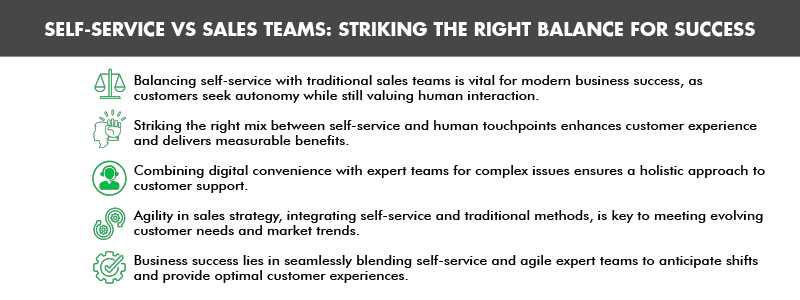Self-Service vs Sales Teams: Striking the Right Balance for Success

These days, businesses – and consumers – are relying on self-service options more than ever. What does this mean for traditional sales teams and how do you strike a balance for success? Read on to find out.

As we navigate the digital age, self-service sales have emerged as a significant trend. This shift from traditional human-led sales to automated platforms has been largely driven by customers’ desire for autonomy and efficiency. And this is especially true in B2B sales, as today's decision-makers prefer using self-service tools rather than engaging with a representative when reordering products or services.
This preference reflects a desire for customers to have more autonomy in their purchasing decisions, allowing them to access information and make purchases on their own terms without interference or pressure from salespeople. In a self-service world, customers can access information and make purchases on their own terms whenever and wherever they want.
While there are substantial benefits to this approach, it also comes with challenges that need to be navigated. Incorporating self-service options into your sales strategy requires not only technological investment but also a clear focus on prioritizing customer experience above all else.
It’s also important to understand that self-service won’t work in every case – for most businesses, a traditional sales team is still very necessary for success. As we delve deeper into this topic, we’ll explore how to strike an optimal balance between maintaining human touch points within your organization and leveraging automation solutions effectively.
Balancing human sales teams with self-service options
Finding equilibrium between human sales teams and self-service options is key to successful selling in the digital age. This blend not only refines customer experience but also delivers measurable business benefits.
The labyrinthine nature of customer networks demands a deft combination of both personal interaction and automated solutions. Nimbly navigating these intricate networks can help companies substantially raise customer-satisfaction scores while minimizing programming time.
A case in point is Climate Corporation, an affiliate of Monsanto. It has achieved considerable success by employing small teams of experts who cater to specific client needs, thereby acknowledging each individual customer's worth effectively.
This approach empowers businesses like Climate Corporation to respond to each customer’s unique requirements adeptly without sacrificing service quality or delivery speed. And it’s this strategic harmony between human touchpoints and automated services that drives success amidst intensifying global competition today.
Challenges in implementing self-service solutions
The journey towards self-service solutions is like navigating a ship through uncharted waters. Every business faces its own unique set of challenges. In many cases, human support is more than optional – it’s essential. Consider an agrochemical company that serves customers who source raw materials from all over the world. When a customer calls in with complex requirements, that’s not something an automated system can handle alone.
In this case, an expert team would step up to provide personalized advice and assistance tailored to this individual customer's needs, a perfect example of meeting special requirements while raising those coveted customer satisfaction scores.
Scenarios like this one underscore the importance of striking a balance between convenient self-service options and dedicated teams who understand every nuance of their product or service. In today’s competitive environment, most businesses need to provide their customers with the best of both worlds in order to succeed.
Best practices for implementing self-service options
Incorporating self-service options into your sales approach can be a real boon to your bottom line, but you have to make sure that these tools are enhancing – rather than replacing – traditional customer support. Here’s how.
Combine digital and human interactions
The first step in this process is creating hybrid customer journeys that blend digital convenience with human touchpoints. These paths cater to diverse customers – some relish the efficiency of digital platforms while others value personalized service from a representative.
This approach not only elevates the overall customer experience but also delivers measurable business benefits by improving operational efficiency and reducing costs. It aligns well with an increasingly complex world where companies substantially raise customer-satisfaction scores through innovative approaches.
Employ small expert teams for complex issues
No matter how advanced automation becomes, there will always be intricate issues requiring human attention. In such scenarios, small expert teams are invaluable assets capable of navigating intricate customer networks beyond automated services’ reach.
Data indicates that smaller groups often outperform larger ones due to increased agility and better communication channels. Key success factors regularly emerge when dealing with challenging deals involving extensive auditing or complex negotiations.
Future directions in sales strategy
In a world of intensifying global competition and escalating demands for personalized customer experiences, companies are being compelled to reassess their sales strategies. The future will likely witness a continued equilibrium between traditional sales teams and self-service platforms, with an amplified emphasis on agility.
Diversified industrial-goods manufacturers have been at the forefront of this shift towards agile approaches. They’ve gleaned valuable lessons from past experiences that flexibility is crucial when dealing with rapidly changing market conditions or evolving customer needs.
By adopting similar methodologies, other businesses can ensure that they’re equipped to respond swiftly and effectively to changes in their industries – meeting customers’ unanticipated needs while navigating intricate customer networks.
This isn't just about swift reactions, however. It’s also about proactively shaping your strategy based on trends and insights derived from data analysis. Employing agile methods enables organizations to anticipate shifts in demand patterns before they occur, giving them time to adjust their approach accordingly – a key success factor among industry-leading companies that respond well under pressure.
Conclusion
The combination of self-service options with traditional sales has become a cornerstone of modern business success. Increasing demand for self-service reflects a shift towards digital autonomy, yet the human touch remains vital for complex issues. Finding the right balance between the two can enhance customer experience, boost win rates, and lower costs significantly.
Implementing self-service is not without its challenges, however. And the real winners in the race to improved customer satisfaction are companies that seamlessly integrate self-service options with agile expert teams that have the ability to swiftly adjust to shifting market conditions or customer desires.
If you're ready to navigate this delicate balance effectively while building an expert sales team that can respond quickly and professionally to your customers’ unique needs, MetaGrowth is ready to assist you. With thousands of hours of experience in recruiting, hiring, training, and managing top sales talent, our experts can mold your staff into the sales team of your dreams, freeing you up to focus on what truly matters - growth! Schedule a strategy session with us today to learn more.
Written by
Josh Hirsch
